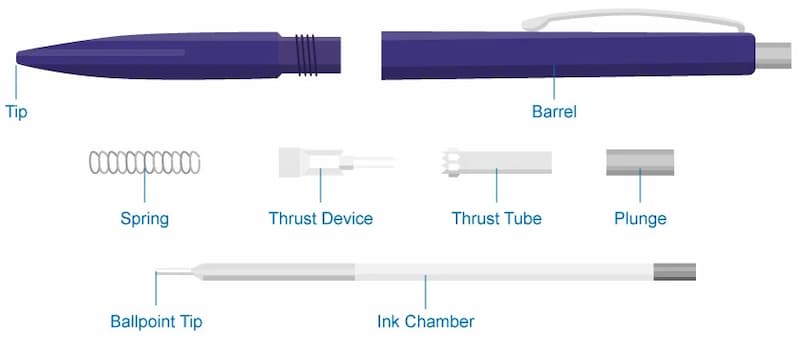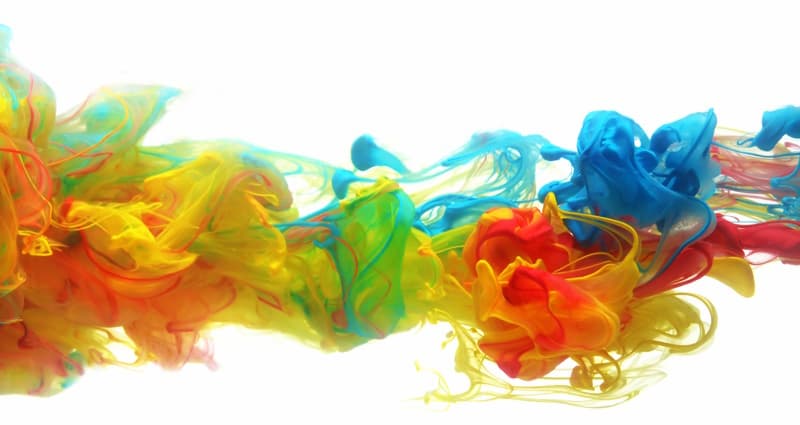
18 January, 2024
The Ergonomics of Pens: Finding the Best Pen for Long Writing Sessions
For many, writing by hand is not only a necessity but also a joy. Whether it's a student taking extensive notes or a writer working on their next masterpiece, a comfortable pen can make a world of difference. In this blog, we'll look at the ergonomics of pens and how to find the most comfortable options for long writing sessions.
What is Ergonomics?
Ergonomics studies people's efficiency and comfort in their working environment. In the context of pens, ergonomics refers to how well a pen fits in your hand, how smoothly it writes, and how it affects your hand and wrist during prolonged use.
The Anatomy of a Pen
Before diving into specifics, it's useful to understand the anatomy of a pen. The main components to consider are the grip, the barrel, the tip, and the ink flow.

1) Grip
- Rubberised Grips: Rubberised grips offer a tactile surface that prevents the pen from slipping out of your fingers, especially during prolonged writing sessions. The cushioned surface allows you to hold the pen without squeezing it too tightly, which can minimise strain on your fingers and wrists.
- Textured Grips
Some pens come with textured grips that feature patterns or small protrusions to increase friction and provide a secure hold. These are particularly useful for people who tend to have sweaty palms or for those writing in quick, rapid motions where grip stability is crucial. It also ensures control without requiring excessive pressure.
2) Barrel
- Thick Barrels: A pen with a thick barrel helps distribute the pressure across your hand more evenly, thereby reducing localised strain. These thicker barrels are often preferable for extended writing sessions because they allow you to write for longer periods without experiencing fatigue. Renowned brands like Lamy are known for offering pens with thicker barrels that prioritise comfort.
- Thin Barrels: In contrast, thin-barreled pens offer more precision in writing, allowing for neater, more controlled strokes. However, they often require you to maintain a tighter grip, which could lead to more hand fatigue over extended periods. Executive and luxury pen lines from brands such as Cross often feature slender designs that prioritise aesthetic and precision over ergonomic comfort.
3) Tip
- Ballpoint Pens: These feature a small ball at the tip that rotates to distribute ink onto the paper. These are known for their durability and longevity. However, they require more pressure to write, which could contribute to hand fatigue over extended periods of use. An additional point to consider is that ballpoint ink dries quickly, reducing the likelihood of smudging, which can be particularly useful for left-handed writers.
- Rollerball Pens: These utilise liquid or gel ink that flows much more freely compared to ballpoints, allowing for a smoother, more fluid writing experience. While they require less pressure, making it easier on your hand, they are more prone to smudging and ink leakage. An added consideration is the variety of ink colours and styles available for rollerball pens, which can offer greater customisation options for the user.
- Fountain Pens: They are often considered the epitome of a luxurious writing experience. They offer the smoothest ink flow but come with the trade-off of needing regular maintenance and ink refills. The high-quality nibs also allow for greater variation in line thickness, lending a unique character to your writing. A less-often-discussed point is that using a fountain pen can be an exercise in mindfulness, as it forces you to focus more on the act of writing, from the angle of the nib to the pressure applied.
- Gel Pens: These combine some of the best ballpoint and rollerball pens features. They use a gel-based ink that flows smoothly like a rollerball but dries quickly like a ballpoint, minimising the risk of smudging. However, they can sometimes be inconsistent in ink flow, requiring occasional scribbling to get the ink moving again.
- Felt-Tip Pens: Felt-tip pens have a porous tip made of fibrous material. These pens provide a smooth, paint-like application and are often used for tasks requiring bold lines or colouring. They are excellent for artistic endeavours but might not be the best choice for long writing sessions due to the speed at which they deplete ink and the potential for the tip to fray.
Ink Flow
Ink flow can vary significantly depending on the type of ink used in the pen. Here's a breakdown of different types of ink and how they impact ink flow and, subsequently, writing comfort:

1) Gel Ink
Consistency and Smoothness: Gel ink is known for its smooth and consistent flow, making it a popular choice for those who seek a frictionless writing experience. The gel formula allows for bold and vibrant lines, which can be particularly pleasing for those who enjoy seeing their words "pop" on the page.
Fatigue Factor: Because gel ink flows smoothly, it minimises the need for pressing down hard on the paper, thus reducing hand fatigue during extended writing sessions. However, the downside is that gel ink may be prone to smudging, especially for left-handed writers.
2) Liquid Ink
Consistency and Smoothness: Liquid ink, often found in rollerball pens, provides a very fluid and consistent writing experience. The ink flows freely and seldom skips, making for uninterrupted writing.
Fatigue Factor: The ease of ink flow means you can write with minimal pressure, which is less taxing on your hand muscles over time. However, like gel ink, liquid ink is susceptible to smudging and might not dry as quickly as other types of ink.
3) Oil-Based Ink
Consistency and Smoothness: Oil-based ink, commonly used in ballpoint pens, is known for its longevity and resistance to drying out. However, it does not offer as smooth an experience as gel or liquid inks, requiring more pressure to maintain a consistent line.
Fatigue Factor: Because they require more pressure, pens with oil-based ink can lead to quicker hand fatigue during prolonged writing sessions. However, they are less prone to smudging and are generally more versatile on different paper types.
4) Water-Based Ink
Consistency and Smoothness: Water-based inks are less common but offer a middle-ground experience between gel and oil-based inks. They provide a decent level of smoothness and are less likely to smudge than gel or liquid inks.
Fatigue Factor: These inks still allow for a relatively effortless writing experience, although they may not be as smooth as gel or liquid inks. However, they dry quickly, making them a good option for those concerned about smudging.
By understanding the characteristics of these different ink types, you can make a more informed decision on the most comfortable and suitable pen for your long writing sessions.
Weight Distribution
Regarding weight distribution, a well-balanced pen can make all the difference in the world during long writing sessions. A pen that's too top-heavy can create extra work for your fingers and wrist, while one that's too bottom-heavy might require more effort to control. Ideally, look for pens with evenly distributed weight to promote a natural writing posture. Some pens are designed with a weight distribution slightly skewed towards the tip; this can enhance control and stability during writing, making it easier to maintain a consistent line.

1) Material
The material from which a pen is made can greatly affect how it feels in the hand and how quickly you tire during extended writing. Pens made from heavy materials like stainless steel or brass may feel solid and high-quality but can quickly become burdensome during long writing sessions. On the other hand, pens made from lightweight materials such as plastic or aluminium offer the advantage of reduced hand fatigue. They are easier to manipulate and hold for extended periods, allowing you to write longer without discomfort.
2) Grip Position
The grip position is a subjective preference but an important one. A higher grip, closer to the pen's tip, often provides greater control and precision. This is particularly beneficial for tasks that require fine detail, such as sketching or calligraphy. However, a high grip might mean a tighter hold, which could lead to faster hand fatigue. Conversely, a lower grip position can promote a more relaxed writing style, potentially reducing muscle strain during prolonged periods. A lower grip usually engages more of the hand in a relaxed manner, spreading the workload across different muscles.
By considering these factors, you can make a more informed decision when selecting a pen for long writing sessions, ensuring that the pen not only suits your writing style and minimises hand fatigue.
Personal Preferences
It's vital to remember that comfort is an extremely personal metric, varying from person to person. Ergonomically designed pens that are raved about by one individual could be completely unsuitable for another due to differences in hand size, grip style, or writing pressure. Therefore, it's always advisable to 'try before you buy' when looking for a pen for extended writing sessions.
If you're in a store, take a few minutes to test out different pens on some scrap paper. Pay attention to how the pen feels in your hand and how your hand feels after a few sentences. If you're shopping online, reading through reviews or ordering a sample, if possible, may be beneficial. Some online retailers also offer hassle-free return policies, which can be helpful for those who are unsure of their preferences.
Taking the time to understand your comfort level and needs can save you money and the physical discomfort of using an unsuitable writing instrument. Remember, the most advertised or expensive pen won't necessarily be the best fit for you. Personal comfort should be your ultimate deciding factor.
Conclusion
The pen may be mightier than the sword, but it must also be kinder to the hand that wields it. Ergonomically designed pens not only make writing more enjoyable but also help minimise strain and discomfort during long writing sessions. So, the next time you're in the market for a pen, remember to consider its ergonomics; your hands will thank you.
The Pens Only Team

